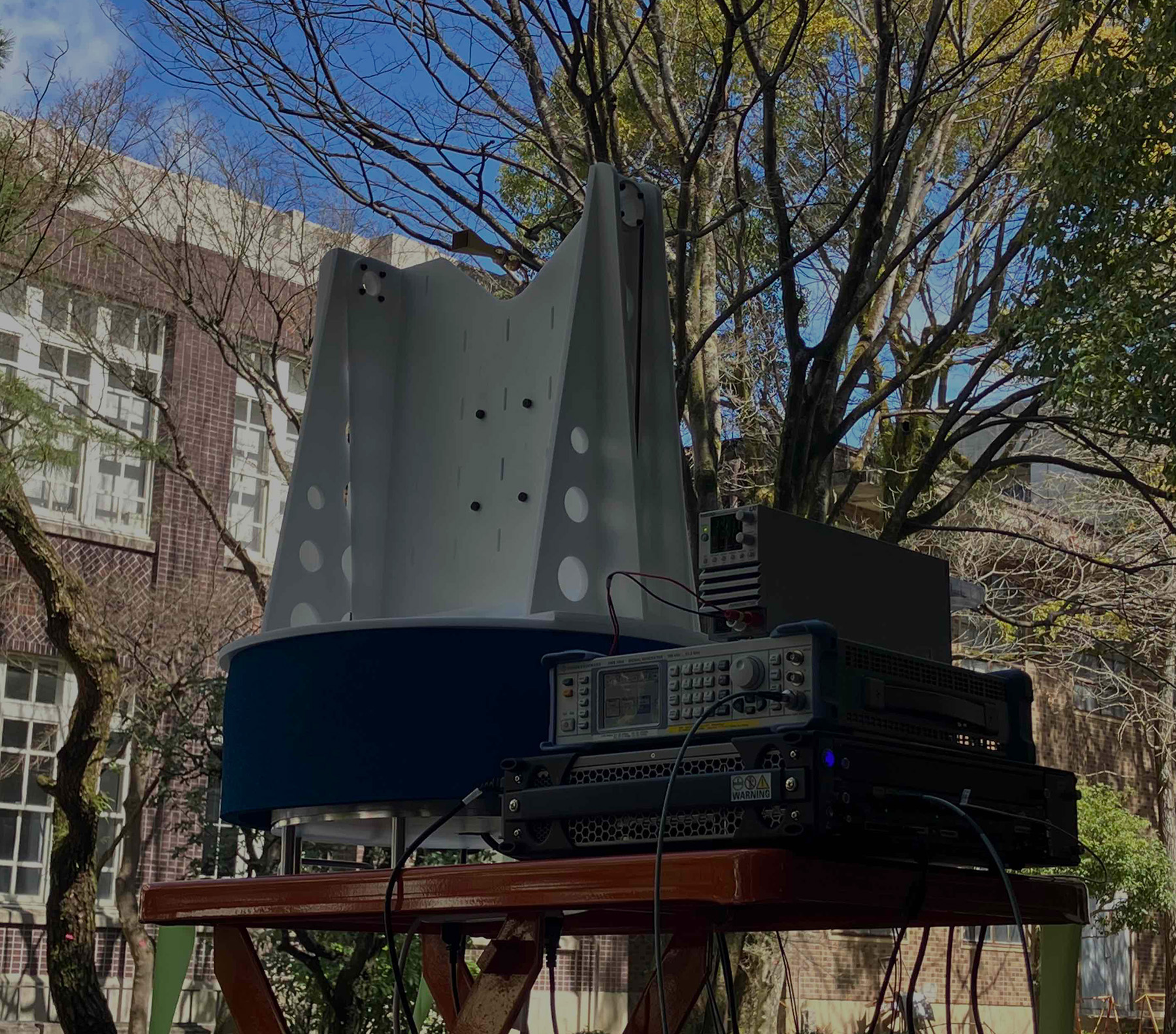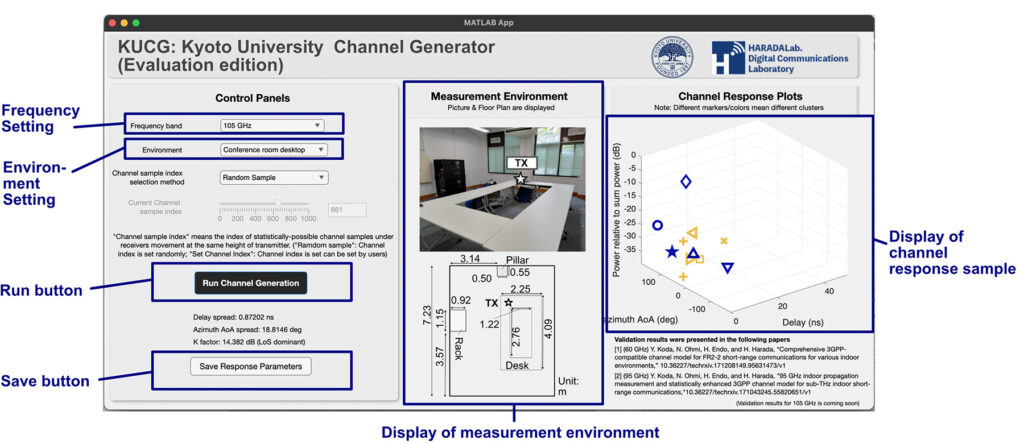General
|
Kyoto University (link-level) channel generator, a.k.a KUCG, powered by MATLAB, is an interactive and intuitive platform to generate channel impulse responses for 60 GHz (millimeter wave), 95 GHz and 105 GHz (sub-THz) bands, which are all based on real-world channel measurements conducted by the Kyoto University Harada Lab. The output file of the channel impulse response can be immediately used for mmw/sub-THz link-level simulations. |
Quick View of KUCG
Configurations
The generated channel impulse responses are link-level and are applicable for mmWave and sub-THz link-level simulations. Possible static channel samples for RX movement or other environment change in the defined environment are output in a .mat file.
Defined Scenarios
The following frequencies and indoor short-range environments are defined:
- 60 GHz Conference room desktop (5m x 7m, RX-TX distance are 1–4m).
- 60 GHz Corridor (35m x 2m, RX-TX distance are 1–4m).
- 60 GHz Office (12m x 7m, RX-TX distance are 2–5m).
- 95 GHz Conference room desktop (5m x 7m, RX-TX distance are 1–4m).
- 105 GHz Conference room desktop (5m x 7m, RX-TX distance are 1–4m).
Antenna Configurations in Measurement
- TX antenna: Omnidirectional antenna. AoD is not generated.
- RX antenna: 25 dBi horn antenna, 360° azimuth scan. Azimuth AoA is generated while elevation AoA is not generated.
For more information on our measurement, please refer to [1–5].
Output file format
- Output file format is “.mat” (named as .mat), which includes:
- Delay_spread (1×1 double):RMS delay spread (ns)
- Azimuth_AoA_spread (1×1 double): RMS azimuth AoA spread (deg)
- K_factor (1×1 double) : Rician K factor (dB)
- Ray_delays (1x double): Delay time of each arrival ray (s)
- Ray_aoas (1x double): Azimuth AoA of each arrival ray (deg)
- Ray_powers (1x double): Power of each arrival ray (W), which is normalized as 1 W in total.
Release Note
V. 1.0.1.
The support programs for the link-level simulation based on the KUCG-generated channels are now accompanied with the KUCG.
V. 1.0.0.
The evaluation edition has been launched! 60 GHz, 95 GHz, and 105 GHz channel models for the above indoor short-range scenarios are implemented.
Downloads
Download KUCG evaluation edition V. 1.0.0.
Software Requirement:
Matlab must already be installed.
Recommended Matlab version:
Above 2023b is recommended.
Terms of Use
Copyright (c) 2024–2025, Kyoto University, Digital Communications Laboratory | Harada Lab.
– Users shall cite either [1] or [2] regarding this work from Kyoto University when using this software.
Y. Koda and H. Harada, “User Guide for Sub-THz Link-Level Evaluations Based on Kyoto University Channel Generator,” Techrxiv.
香田優介,原田博司「[依頼講演] 統計的チャネルモデルに基づくミリ波・サブテラヘルツ帯チャネルシミュレータ ~利用方法と基本伝送特性評価事例~」信学技報,2025年6月.
– Users shall cite the relevant articles from Kyoto University if KUCG-generated channel samples are used.
– The use of this software for any purposes directly associated with weapons or weapons of mass destruction is prohibited.
– Users are permitted to make secondary use of the software. Any copyrights or intellectual property rights arising from research conducted using this software shall be retained by the user.
– The use of this software for the development of products and the provision or sale of services is permitted.
– THE SOFTWARE IS PROVIDED “AS IS”, WITHOUT WARRANTY OF ANY KIND, EXPRESS OR IMPLIED, INCLUDING BUT NOT LIMITED TO THE WARRANTIES OF MERCHANTABILITY, FITNESS FOR A PARTICULAR PURPOSE AND NONINFRINGEMENT. IN NO EVENT SHALL THE AUTHORS OR COPYRIGHT HOLDERS BE LIABLE FOR ANY CLAIM, DAMAGES OR OTHER LIABILITY, WHETHER INANACTION OF CONTRACT, TORT OR OTHERWISE, ARISING FROM, OUT OF OR IN CONNECTION WITH THE SOFTWARE
– The above copyright notice and this permission notice shall be included in all copies or substantial portions of the Software.
Publications
[6] (60 GHz Model descriptions & Validation) Y. Koda, N. Ohmi, H. Endo, and H. Harada, “Comprehensive 3GPP-compatible channel model for FR2-2 short-range communications for various indoor environments,” techrxiv, 10.36227/techrxiv.171208149.95631473/v1
[5] (95 GHz Model descriptions & Validation) Y. Koda, N. Ohmi, H. Endo, and H. Harada, “95 GHz indoor propagation measurement and statistically enhanced 3GPP channel model for sub-THz indoor short-range communications,” techrxiv, 10.36227/techrxiv.171043245.55820651/v1
[4] (105 GHz Model descriptions) M. Hashimoto, Y. Koda, N. Ohmi, and H. Harada, “Measurements of Delay Profile at 105 GHz in Conference Room Desktop Environment,” IEICE Tech. Rep., vol. 123, no. 436, SRW2023-61, pp. 78-83, March 2024.
[3] (95 GHz Measurement descriptions) Y. Koda, N. Ohmi, H. Endo, and H. Harada, “95 GHz sub-THz multi-path propagation measurement for indoor conference room desktop,” accepted at IEEE WCNC 2024.
[2] (105 GHz Measurement descriptions) Y. Koda, N. Ohmi, H. Endo, and H. Harada, “105 GHz multipath propagation measurements and path loss model for sub-THz indoor short-range communications,” in Proc. IEEE VTC2023-Fall, Hong Kong, Oct. 2023, pp. 1–6.
[1] (Our philosophy for mmW/THz statistical channel model) Y. Koda, R. Ouyang, N. Ohmi, and H. Harada, “Survey, taxonomy, and unification of standard mmWave channel models for WPAN, WLAN, and cellular systems in 6G,” accepted for IEEE Communications Standards Magazine.
Acknowledgements
This project is partly supported by the commissioned research (No. JPJ012368C04201) by the National Institute of Information and Communications Technology (NICT), Japan and the Ministry of Internal Affairs and Communications in Japan (SCOPE #JPJ00595).
Contact
Prof. Hiroshi Harada:
hiroshi.harada [at] i.kyoto-u.ac.jp
Assistant Prof. Yusuke Koda:
koda [at] i.kyoto-u.ac.jp
※Please change [at] to @



